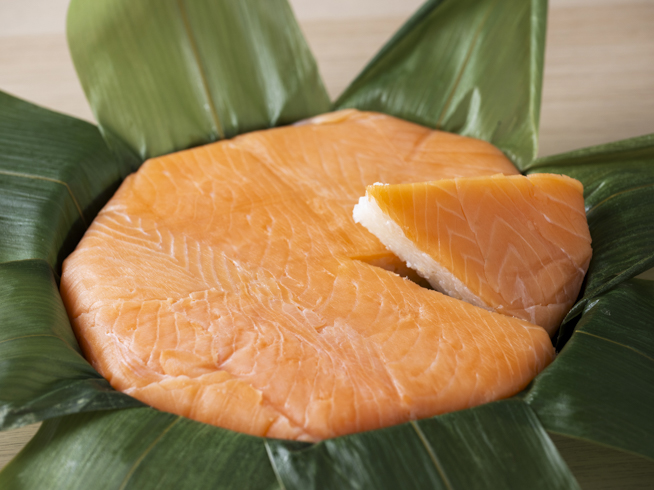Masu-zushi (Trout sushi wrapped in leaves) | Traditional Foods in Japan

Masu-zushi (Trout sushi wrapped in leaves)

ToyamaMasuzushi
Classification (Large)
Seafood
Classification (Small)
Fermented seafood products
Main ingredients used
Trout, rice
When using downloaded images, please read the "Terms of Use" and clearly state that the source of the image is "Traditional Foods in Japan" by the Ministry of Agriculture, Forestry and Fisheries.
If the photo credits is stated, please include it as well.
Example of description
of the photo credits
Example of description when the photo credits is not stated
Source: "Traditional Foods in Japan" Ministry of Agriculture, Forestry and Fisheries Example of description when the photo credits is stated
Source: "Traditional Foods in Japan" Ministry of Agriculture, Forestry and Fisheries
Photo credits:xxx
Region of inheritance
Throughout the prefecture
Product overview (special characteristics and types)
Masuzushi is one of the most famous specialties of Toyama Prefecture. It is a pressed sushi created by layering vinegared rice and slices of trout on bamboo grass in a bentwood food box to be pressed. There are single-layer and double-layer varieties, and these have a shelf life of three to four days, even in the summer. It is also very popular as a souvenir.
History and culture
There are various theories regarding the origin of this dish, including records dating back to the year 845 (Jowa 8). The commonly accepted story states the dish was born in 1717 (Kyoho 2), when Shinpachi Yoshimura, a samurai of the Toyama Domain, first prepared sushi with ayu from the Jinzugawa River with locally produced rice to offer to Toshioki Maeda, the third lord of the domain. Following that, it was presented to the shogun at that time, Yoshimune Tokugawa, and became a Toyama specialty after the shogun was extremely pleased with it. Over time, cherry salmon traveling to the Jinzugawa River in the spring replaced ayu for masuzushi, and the present version of the dish was established between the end of the Edo period and the early Meiji era. Masuzushi also was sold as train station bento with the opening of the Hokuriku rail line, which boosted its popularity across Japan.
Production method
Masuzushi is created by arranging bamboo grass in a radial pattern at the bottom of a bentwood food box, and evenly spreading vinegared rice on top. Thin slices of salted and vinegar-cured cherry salmon are arranged over the rice, after which the bamboo grass is folded over in order to create a lid to cover the layers. This process is repeated for multiple layers, and a weight is placed on this for several hours to complete the dish. Masuzushi continues to age after completion, and it is said to have the richest flavor on the second day.
The fatty cherry salmon harvested around June is the preferred fish for this dish, but chum salmon is also used. Additionally, there is another way to prepare this dish called uraoki, in which the fish is placed underneath the vinegared rice.
Masuzushi is best stored at room temperature, as the vinegared rice hardens when refrigerated. It can be stored indoors during spring and autumn, and a warm environment is preferrable for storage during the winter.
Conservation and succession efforts
The taste of masuzushi differs between stores. However, in recent years, there are products using less vinegar to accommodate consumer preferences. Furthermore, there are also frozen products available to enable those living far away to enjoy fresh masuzushi.
Visitors can learn about the history of masuzushi and experience the craftmanship passed down over the ages at the Masunosushi Museum in Toyama City. The museum also offers factory tours and hands-on masuzushi making experiences.
The Toyama Masuzushi Cooperative also promotes masuzushi through hands-on experiences along with the production and distribution of the Masuzushi Tasting Map.
There are other businesses that dispatch hands-on workshops to other regions as well.
Main consumption method
Masuzushi is often sold as a train station bento, and also can be found in supermarkets, convenience stores, and highway service areas. There are more than thirty producers in Toyama City alone, and as each producer has their distinct approach to the dish, such as the thickness of the fish, the balance of vinegar and salt, and the firmness of pressed rice, consumers can have fun comparing products. The dish is often enjoyed during special events such as festivals, Obon, and the New Year’s holiday, and many people purchase it as a souvenir or gift.
Contact
Food Cultures Office, Overseas Market Development and Food Cultures Division, Food Industry Affairs Bureau, Ministry of Agriculture, Forestry and Fisheries
Tel:+81-3-3502-5516




